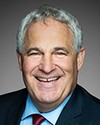Thank you.
I'm going to dispense with formalities.
Tom, you're next.
Evidence of meeting #5 for Natural Resources in the 42nd Parliament, 1st session. (The original version is on Parliament’s site, as are the minutes.) The winning word was technology.
A recording is available from Parliament.
Liberal

The Chair Liberal James Maloney
Thank you.
I'm going to dispense with formalities.
Tom, you're next.
Conservative

Tom Kmiec Conservative Calgary Shepard, AB
Thank you, Mr. Chair.
Thank you, Dan. It's great to see another Calgarian here telling us the good story of what the industry is doing. It's a pretty progressive approach. Your companies have given up a competitive advantage. You gave us the ratio of 13:1 as the leverage you're getting out of this.
I'm going to build on the question of my colleague.
You said there is no comparable COSIA in another sector of the economy in Canada. What about internationally, such as Saudi Arabia or Nigeria or one of these places with a sole state-owned company that runs the entire operation from A to Z? How do they compare in innovation, entrepreneurship, and innovating from the top down? It's probably different over there from here.
Can you talk more about that?
Chief Executive, Canada's Oil Sands Innovation Alliance
Yes, when you talk about the range of innovation models or approaches used by countries or individual companies in a state-owned model, it really is a whole continuum.
I think we have the best of both worlds here, because we have the structure within which companies can collaborate, yet we have the individual entrepreneurship of individuals and teams and companies. The trick and the art is to bring that together in a way that yields results.
One of the criticisms, frankly, that some of the company staff had when we launched COSIA four years ago was around where the incentive was for the individual or the company to innovate, and whether that was really at the scale of the company.
When you think about what COSIA is, it's a recognition that these companies are all in it together, and they will succeed together. They're still in competition, but they're in competition with other energy sources and other geographies. What we've done inside of COSIA is we've characterized and formalized the scale of competition as being different from what it was four years ago, because it is different. This is a made-in-Canada model for the companies to be able to deliver.
All that said, we keep finding out about different types of alliances and so on across sectors, but when you poke in and scratch underneath the surface, to date we still don't know of anyone that pushes it as deeply as COSIA does.
Conservative

Tom Kmiec Conservative Calgary Shepard, AB
I can always tell when I'm talking to an Albertan; it's the “can do” attitude. I can just hear it in your voice: “There's no challenge we can't surmount, nothing that can defeat us; there's always a solution to a problem.”
You talked about some of these technologies like the SkyStrat flying rig, the rifle tubing, the eye-in-the-sky satellite. What do you do to highlight the contributions of the individual? A lot of these people are living in my riding. Some of them are unemployed right now. What do you do for those technical specialists, the actual innovators of the technology? How do you recognize their success? How do you recognize what they're doing, not just for the particular company, but also for their field? These are some of the best people in the world at what they do. I meet these people. My neighbours are some of the best people in the world in LNG development, for example. How do we praise their craftsmanship? How does COSIA do that, and how does the industry do that in Calgary, in Alberta, and in Canada?
Chief Executive, Canada's Oil Sands Innovation Alliance
Yes, it's a great point.
One of the things we do have is a newsletter, and in every newsletter we focus on individuals as leaders. In some cases it's strategic leaders, and in some cases it's more technical leaders. That's the way we can draw attention to the fact that innovation really is about a collision of ideas. Those ideas are usually in someone's mind or in some organization, and you want to make these collisions as constructive and productive as possible.
In 2016 we were asked by the companies to take more of a communications role, and part of that communications role is communicating even into the companies themselves, so they can fully wring the value out of COSIA.
It's a great point, and it's something we've done, but we're going to stress that more in the future.
Conservative

Tom Kmiec Conservative Calgary Shepard, AB
It will be very short then.
Can anyone join as a core member outside of the ones you have elaborated? Are you open to taking new members to form part of a core group? MEG Energy comes to mind.
Chief Executive, Canada's Oil Sands Innovation Alliance
Yes, absolutely. We're completely open.
As you might expect, we have legal documents to make this real. There is a lot of money at play. There is a competition law. Oil sands companies can join. We have some membership criteria.
More importantly, any organization or individual in the world can be part of a project that COSIA has, and they get to keep their intellectual property rights. We have a completely open door policy with, as you might expect, some prescriptions in terms of criteria.
Liberal
Liberal

Marc Serré Liberal Nickel Belt, ON
Thank you, Mr. Chair.
Thank you for telling us about the activities COSIA has been working on. It's fascinating stuff. Your alliance is doing some wonderful work.
You said the alliance was quiet in the years prior to 2016. I think it's high time that we take a more proactive approach in talking about the innovative work the industry is doing. I think that's really important.
Drawing a parallel with something that was mentioned earlier, I would point to the Centre for Excellence in Mining Innovation, known as CEMI, and Laurentian Mining Innovation and Technology. Those organizations have done more or less the same thing your alliance is doing, but for the mining industry, in terms of creating hubs and university partnerships. Keep up the good work.
You're involved in a lot of R and D and you've established partnerships with universities, which you mentioned. Once the research phase is complete, you begin working with companies on the implementation phase. It's very expensive for a company to pursue R and D activities.
I have a question about the third step in the process, so the implementation of the technology once the R and D is complete. What can the government do to help companies adopt these new technologies? Traditionally, companies, like workers, are slow to adopt change. It takes a certain amount of time. What can we do to help you in that regard and ensure that companies have the resources they need to put your innovations in place?
Chief Executive, Canada's Oil Sands Innovation Alliance
I'd answer that question by saying that you're absolutely right when you talk about a sequence of events going from research and development to implementation.
The best way to implement technologies is to be working on the right technologies to begin with. A poorly tuned and poorly structured innovation system creates many technologies or products or services and then tries to find an application for them. I must admit, we have hundreds of people or organizations coming to us as COSIA, trying, and this is a figure of speech, to sell the companies a hammer. They're saying, “Could we test your hammer?” when frankly what the companies need is a certain type of screwdriver.
I think a properly tuned innovation system starts with the end in mind. It is a directed innovation: what specific types of technologies do we need, and how would we develop them in ways that allow their implementation to be easy? It's difficult, but we spend a lot of time planning that, but then it's set up so that when people start to work on earlier stages of innovation—ideation, discovery, development, demonstration—they actually don't have to work at implementation. There are companies pulling it; you have companies demanding those types of products.
One thing I would say is that for the government to be part of, first of all, a directed innovation ecosystem that does not just rely on bottom-up good ideas but relies on very clear contact with industry about the commercial application before we start working.... To the extent that the government can be part of that fine-tuned innovation system, it would be very welcome.
There are good examples, but I believe there are opportunities for improvement in this area.
Liberal

Marc Serré Liberal Nickel Belt, ON
Thank you so much for that.
What do you in COSIA see as the most important, significant environmental concern in the oil sands and their development?
Chief Executive, Canada's Oil Sands Innovation Alliance
I respect your question, but it's getting dangerously close to my non-policy and non-regulatory position. What I would say is this. The companies have a priori defined four key areas: water, land, tailings, and greenhouse gases. From a purely technical perspective, those are the areas. They're definitely intertwined.
Speaking as a citizen of Canada, I would say that most of the international discourse, of course, is around greenhouse gases, and I'm happy to say that's one of our four priority areas.
Liberal

Marc Serré Liberal Nickel Belt, ON
With respect to R and D and research for COSIA, how has the oil pricing around the world right now affected your ability to do more R and D and research?
Chief Executive, Canada's Oil Sands Innovation Alliance
What I can say is that COSIA is about leverage. It's about companies working together and having synergies: merging properties and doing projects that are too large for each individual company to do, so they have to do them together.
If that comment about leverage made sense four years ago when oil was at a high price, it makes as much or more sense now. All the evidence I have—I'm a scientist, so I deal with data—is that the companies are absolutely committed to COSIA and to environmental performance improvement. Our project count went up in 2015, not down, and the dollar value of our project portfolio was essentially constant.
Having said that, these are extremely difficult economic conditions for those companies. For many of them, they are just not sustainable. That provides a very large caveat to my notion of the level of commitment the companies have.
Liberal

The Chair Liberal James Maloney
Thank you.
Mr. Cannings, over to you for the last round of questions. You have three minutes.
NDP

Richard Cannings NDP South Okanagan—West Kootenay, BC
You mentioned that you're a biologist. I know you're an aquatic biologist. As a biologist myself, I thought I'd throw a last biology question at you. It's not about aquatic biology; it's about caribou.
You mentioned caribou before and the work that COSIA has been doing. I know caribou are notoriously sensitive to changes in the landscape, to changes to old-growth forests. I'm wondering what your sense is of the future of caribou in this landscape, given how long it takes for these habitat enhancements you talked about to really take hold.
Chief Executive, Canada's Oil Sands Innovation Alliance
[Technical difficulty—Editor] to a positive future. Let me give you an example of some of the ways companies are working towards that.
Right now it's a difficult operating environment up in northern Alberta to reclaim the land. Much of it is essentially muskeg. It's very difficult or impossible to get a mechanical vehicle on the landscape for eight months of the year. If you go on it in the summer, you put these huge ruts in the landscape. If you go on it in the winter, it's difficult, for example, to plant trees.
Two projects come to mind.
One is something we call faster forests. We found that, actually, you can go on the landscape when the muskeg is frozen. You can get on there with mechanical machines, but there's no impact or very little impact on the landscape, and you can plant spruce trees. You will notice as a biologist that this may be odd, but as it turns out you have very high survivorship for trees planted in the dead of winter. Companies, again through a COSIA project, are figuring out how to accelerate reclamation.
The second thing we have is a new piece of technology that is a way of reclaiming linear disturbance, and by that I mean a road or seismic line. Essentially you have what amounts to a backhoe on a series of big floats. You can take that backhoe to help reclaim these linear disturbances. You can take it on the landscape in the middle of summer when historically that backhoe would quite literally sink into the muskeg. With these series of large floats and a series of implements, you can actually now plant in the summer as well.
This is the kind of thing whereby we think we can speed reclamation by hundreds of percentage points, and frankly, at the same time save costs.
NDP

Richard Cannings NDP South Okanagan—West Kootenay, BC
What do you think about the future of caribou? You mentioned those things, but I'm wondering how those timelines can work to help caribou.
Chief Executive, Canada's Oil Sands Innovation Alliance
I apologize. I thought I spoke to that right off the bat.
I think the future of caribou can actually be managed to a good future. We have endangered species legislation in Alberta. Of course, the Species at Risk Act is overarching federal legislation that gives the Government of Canada certain responsibilities. I know both the federal government and the provincial government [Technical difficulty—Editor].
Liberal
Chief Executive, Canada's Oil Sands Innovation Alliance
I would just say that the planning processes are unfolding now with all the necessary stakeholders. With these new technologies, I believe there's again a viable future for boreal caribou in Canada.
Liberal

The Chair Liberal James Maloney
Excellent.
Mr. Wicklum, thank you very much. We appreciate your taking the time out of your schedule to prepare and especially to present to this group. It was very informative, and it's going to be very helpful in what we're doing here. We all appreciate it.